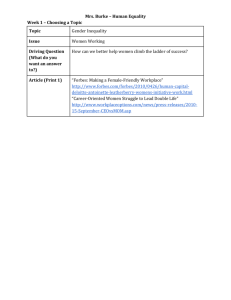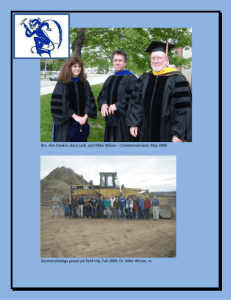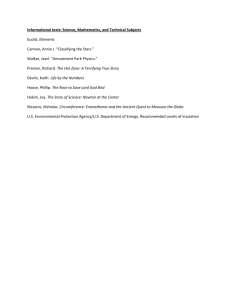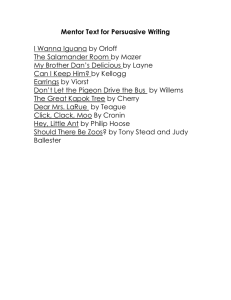The US Navy Japanese/Oriental Language School Archival Project
advertisement
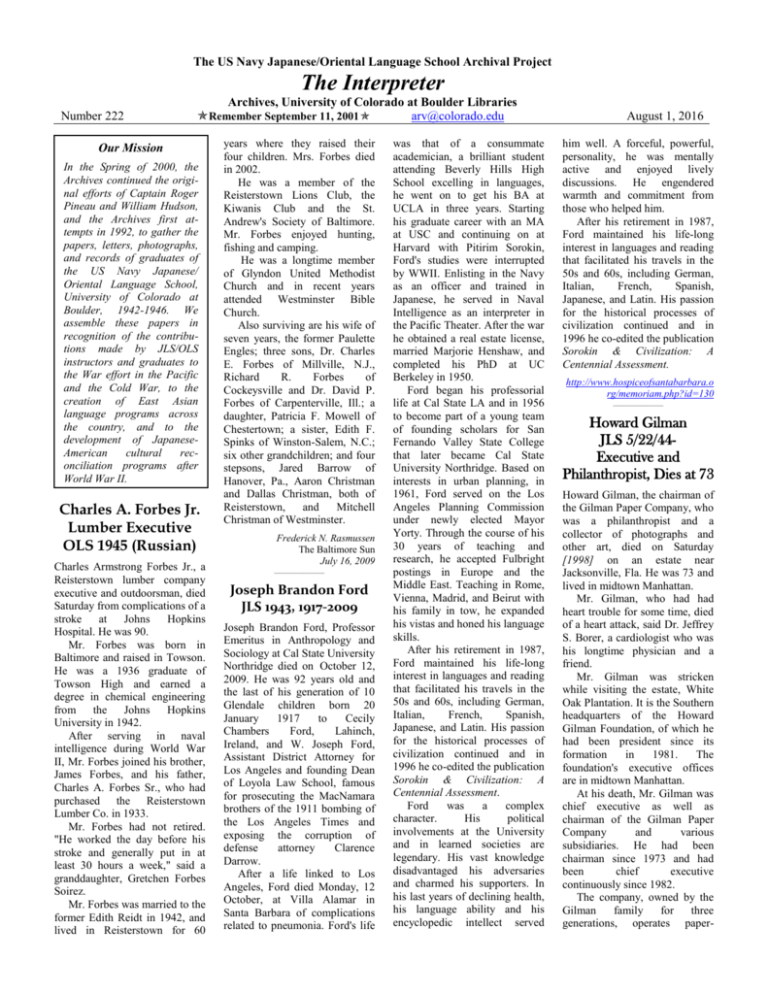
The US Navy Japanese/Oriental Language School Archival Project The Interpreter Number 222 Archives, University of Colorado at Boulder Libraries Remember September 11, 2001 arv@colorado.edu Our Mission In the Spring of 2000, the Archives continued the original efforts of Captain Roger Pineau and William Hudson, and the Archives first attempts in 1992, to gather the papers, letters, photographs, and records of graduates of the US Navy Japanese/ Oriental Language School, University of Colorado at Boulder, 1942-1946. We assemble these papers in recognition of the contributions made by JLS/OLS instructors and graduates to the War effort in the Pacific and the Cold War, to the creation of East Asian language programs across the country, and to the development of JapaneseAmerican cultural reconciliation programs after World War II. Charles A. Forbes Jr. Lumber Executive OLS 1945 (Russian) Charles Armstrong Forbes Jr., a Reisterstown lumber company executive and outdoorsman, died Saturday from complications of a stroke at Johns Hopkins Hospital. He was 90. Mr. Forbes was born in Baltimore and raised in Towson. He was a 1936 graduate of Towson High and earned a degree in chemical engineering from the Johns Hopkins University in 1942. After serving in naval intelligence during World War II, Mr. Forbes joined his brother, James Forbes, and his father, Charles A. Forbes Sr., who had purchased the Reisterstown Lumber Co. in 1933. Mr. Forbes had not retired. "He worked the day before his stroke and generally put in at least 30 hours a week," said a granddaughter, Gretchen Forbes Soirez. Mr. Forbes was married to the former Edith Reidt in 1942, and lived in Reisterstown for 60 years where they raised their four children. Mrs. Forbes died in 2002. He was a member of the Reisterstown Lions Club, the Kiwanis Club and the St. Andrew's Society of Baltimore. Mr. Forbes enjoyed hunting, fishing and camping. He was a longtime member of Glyndon United Methodist Church and in recent years attended Westminster Bible Church. Also surviving are his wife of seven years, the former Paulette Engles; three sons, Dr. Charles E. Forbes of Millville, N.J., Richard R. Forbes of Cockeysville and Dr. David P. Forbes of Carpenterville, Ill.; a daughter, Patricia F. Mowell of Chestertown; a sister, Edith F. Spinks of Winston-Salem, N.C.; six other grandchildren; and four stepsons, Jared Barrow of Hanover, Pa., Aaron Christman and Dallas Christman, both of Reisterstown, and Mitchell Christman of Westminster. Frederick N. Rasmussen The Baltimore Sun July 16, 2009 ________________ Joseph Brandon Ford JLS 1943, 1917-2009 Joseph Brandon Ford, Professor Emeritus in Anthropology and Sociology at Cal State University Northridge died on October 12, 2009. He was 92 years old and the last of his generation of 10 Glendale children born 20 January 1917 to Cecily Chambers Ford, Lahinch, Ireland, and W. Joseph Ford, Assistant District Attorney for Los Angeles and founding Dean of Loyola Law School, famous for prosecuting the MacNamara brothers of the 1911 bombing of the Los Angeles Times and exposing the corruption of defense attorney Clarence Darrow. After a life linked to Los Angeles, Ford died Monday, 12 October, at Villa Alamar in Santa Barbara of complications related to pneumonia. Ford's life was that of a consummate academician, a brilliant student attending Beverly Hills High School excelling in languages, he went on to get his BA at UCLA in three years. Starting his graduate career with an MA at USC and continuing on at Harvard with Pitirim Sorokin, Ford's studies were interrupted by WWII. Enlisting in the Navy as an officer and trained in Japanese, he served in Naval Intelligence as an interpreter in the Pacific Theater. After the war he obtained a real estate license, married Marjorie Henshaw, and completed his PhD at UC Berkeley in 1950. Ford began his professorial life at Cal State LA and in 1956 to become part of a young team of founding scholars for San Fernando Valley State College that later became Cal State University Northridge. Based on interests in urban planning, in 1961, Ford served on the Los Angeles Planning Commission under newly elected Mayor Yorty. Through the course of his 30 years of teaching and research, he accepted Fulbright postings in Europe and the Middle East. Teaching in Rome, Vienna, Madrid, and Beirut with his family in tow, he expanded his vistas and honed his language skills. After his retirement in 1987, Ford maintained his life-long interest in languages and reading that facilitated his travels in the 50s and 60s, including German, Italian, French, Spanish, Japanese, and Latin. His passion for the historical processes of civilization continued and in 1996 he co-edited the publication Sorokin & Civilization: A Centennial Assessment. Ford was a complex character. His political involvements at the University and in learned societies are legendary. His vast knowledge disadvantaged his adversaries and charmed his supporters. In his last years of declining health, his language ability and his encyclopedic intellect served August 1, 2016 him well. A forceful, powerful, personality, he was mentally active and enjoyed lively discussions. He engendered warmth and commitment from those who helped him. After his retirement in 1987, Ford maintained his life-long interest in languages and reading that facilitated his travels in the 50s and 60s, including German, Italian, French, Spanish, Japanese, and Latin. His passion for the historical processes of civilization continued and in 1996 he co-edited the publication Sorokin & Civilization: A Centennial Assessment. http://www.hospiceofsantabarbara.o rg/memoriam.php?id=130 ________________ Howard Gilman JLS 5/22/44Executive and Philanthropist, Dies at 73 Howard Gilman, the chairman of the Gilman Paper Company, who was a philanthropist and a collector of photographs and other art, died on Saturday [1998] on an estate near Jacksonville, Fla. He was 73 and lived in midtown Manhattan. Mr. Gilman, who had had heart trouble for some time, died of a heart attack, said Dr. Jeffrey S. Borer, a cardiologist who was his longtime physician and a friend. Mr. Gilman was stricken while visiting the estate, White Oak Plantation. It is the Southern headquarters of the Howard Gilman Foundation, of which he had been president since its formation in 1981. The foundation's executive offices are in midtown Manhattan. At his death, Mr. Gilman was chief executive as well as chairman of the Gilman Paper Company and various subsidiaries. He had been chairman since 1973 and had been chief executive continuously since 1982. The company, owned by the Gilman family for three generations, operates paper- manufacturing mills in southeastern Georgia and owns forest land, mainly in Georgia and Florida. Its headquarters are also in midtown Manhattan. Mr. Gilman was intensely interested in the preservation of endangered species, art collecting and dance. The Howard Gilman Foundation was set up to support wildlife conservation, activities in the arts, and medical research into H.I.V., AIDS and cardiology. The Gilman Paper Company's collection of about 5,000 photographs was Mr. Gilman's brainchild. The more than 250 photographs in the Metropolitan Museum of Art's 1993 show ''The Waking Dream: Photography's First Century'' were from that collection. The New York Times critic John Russell wrote in The Times that the show was ''an event of cardinal importance in the museum world'' and that the Gilman collection bore ''at every point the mark of an original, resourceful and unprejudiced curiosity.'' The Howard Gilman Foundation also gave the endowment for the Metropolitan Museum's first permanent gallery dedicated exclusively to photography, the Howard Gilman Gallery, which was inaugurated in October. Mr. Gilman's involvement with dance included support for the American Ballet Theatre and numerous other dance companies, Mikhail Baryshnikov and other dancers and choreographers. He also oversaw the formation of a wildlife conservation center, on the White Oak Plantation. Other beneficiaries of his largess include Tel Aviv University, the Tel Aviv Museum of Art, the Israel Philharmonic Orchestra and the Juilliard School in Manhattan. Mr. Gilman was born and reared on Manhattan's Upper East Side, attended Horace Mann School in the Bronx, received a Bachelor's degree in 1944 from Dartmouth, where he was elected to Phi Beta Kappa, and served in the Navy during part of World War II. He is survived by his mother, Sylvia Gilman of Manhattan. Eric Pace New York Times January 5, 1998 ________________ JOHN MERRICK GRAY JR. 88, OLS 3/6/45- Russian WAKEFIELD — John Merrick Gray Jr., age 88, of Wakefield, formerly of Orleans, died January 10, 2013, following a lengthy decline with Alzheimer's. He was the husband of 65 years to the late Mary (Lewis) Gray. Born and raised in Walpole; he was the son of the late J. Merrick and Rose (Mutch) Gray. Mr. Gray graduated from Yale University in 1945. He was an English major and part of the ROTC program that prepared him to serve in WWII as a language officer in the Navy, studying Japanese. He received his Masters of Education at Harvard University and was a Fulbright exchange teacher in Japan in 1960. He was fluent in both written and spoken Japanese. Mr. Gray taught high school English in Newton, Needham, Walpole and Nauset Regional High School in North Eastham, where he was head of the English department. He was also a popular track and cross country coach. In 1964 he worked in Mississipi as a teacher in the Freedom Summer project. Mr. Gray was the sports editor of the Cape Codder in Orleans for over twelve years. He wrote articles published in the Saturday Evening Post, the Boston Globe and Yankee Magazine, and he was the author of "Racewalking for Fun and Fitness". Mr. Gray was an avid runner and ran or race-walked in over 1300 races. He ran in the Boston Marathon 34 times, finishing in the medals (top 35) six times with a personal best of 21st place. He finished in 11th place in the 1964 Olympic Trials marathon in Yonkers, NY. He was also a national masters age group champion in race-walking. Always a competitor, he was an avid tennis player and loved all games. He was the father of Linda Gray and her husband Albert Fournier of Wakefield and Kate Gray Belding and her husband Patrick of Burlingame, CA and the late John Merrick Gray III. He was the grandfather of Julia Fournier Rea, Anne Fournier, Rebecca Belding and Merrick Belding, and great grandfather of Sophie Rea. He was the brother of the late Robert S. Gray. Cape Cod Times January 14, 2013 ________________ David H. Green Death Notice OLS 4/2/45DAVID HITCHCOCK GREEN (Age 84) A retired labormanagement relations policy specialist for the Department of Defense, died of natural causes on April 19, 2010 at his home in Great Falls, VA. David Hitchcock Green was born in Hartford, CT and grew up in West Hartford. After graduating from the Loomis School and World War II service in the Marine Corps, he earned a Master''s degree in international relations in 1950 from the University of Chicago. Following a year as a staff member and instructor in geography at the University of Hawaii, he began his federal Civil Service Career in the Industrial Relations Office of the Pearl Harbor Naval Shipyard. He was one of a handful of Federal employees selected for a midcareer fellowship at Princeton University''s Woodrow Wilson School of Public and International Affairs for the 1962-63 academic year. Mr. Green and his family lived in Hawaii for 17 years before relocating to the Washington area in 1967 for a position in the Navy Department''s Office of Civilian Manpower Management. At the time of his retirement in 1982 he had served for several years in the Office of the Secretary of Defense as Director of Labor Relations Policy, coordinating the handling of labor matters involving civilian personnel at Defense bases in the U.S. and worldwide. He played a significant role in resolving with Japanese officials labor issues involved in the 1972 reversion of Okinawa to Japanese sovereignty, and in dealing with labor issues involved in the implementation of the Panama Canal Treaty of 1978. He was awarded the Secretary of Defense Distinguished Civilian Service medal. After his retirement, Mr. Green maintained his interest in world affairs. He enjoyed gardening, and several of his humorous poems were published. He was a founding member of the Council of Former Federal Executives (COFFE) and a longtime member of the Hawaii State Society of Washington, DC. Mr. Green''s wife of 55 years, Mitsuko Osaki Green, died in 2004. Survivors include three children, Timothy of Las Vegas, NV; Jennifer McDonough of Merrimack, NH; Margaret Wheeler of Atlanta, GA; seven grandchildren and one greatgrandchild; a sister, Margot Torrey of Putney, VT and a brother, John Green of Duluth, MN. Services will be private. Washington Post April 29, 2010 - See more at: http://www.legacy.com/obituaries/wa shingtonpost/obituary.aspx?n=david -hgreen&pid=142327421#sthash.vUiv SepU.dpuf ________________ Charles M. Haar, JLS 1944 Dies at 91; Used Courts to Clean Boston Harbor Charles M. Haar, a Harvard Law School professor who helped spur the cleanup of the notoriously befouled Boston Harbor through the strategic use of judicial power, died on Jan. 10 in Miami. He was 91 and lived in Key Biscayne, Fla., and Princeton, N.J. Mr. Haar advocated robust government regulation of, and intervention in, urban development. In the 1950s, he was among the first law professors anywhere to introduce students — including a young Michael S. Dukakis — to the emerging field of land-use law. In 1958 he wrote the influential “Land-Use Planning: A Casebook on the Use, Misuse and Re-Use of Urban Land.” Mr. Haar was given several chances to put his beliefs into practice on a big scale. In 1966 he helped create the Model Cities program, President Lyndon B. Johnson’s effort to direct federal urban renewal money to specific neighborhoods in cities willing to abide by numerous regulatory criteria. He was later a special courtappointed master in a case filed in 1982 by Quincy, Mass., against the state commission in charge of the metropolitan Boston sewer system. In August 1983, Mr. Haar reported to Judge Paul G. Garrity of Superior Court that Quincy’s beaches were contaminated with fecal matter, tampon applicators, condoms, grease and oil overflowing from the system, and that 863 million gallons of raw sewage had been dumped into the harbor in the first five months of the year. Allowing that he was not the first to document such conditions in the face of official indifference and inaction, Mr. Haar told The New York Times, “If you don’t have a court order, you can kiss this report goodbye.” Fifteen months later, he had that order. Holding a copy of Mr. Haar’s report for the courtroom to see, Judge Garrity ordered a moratorium on any new commercial connections to the Boston sewer system, threatening to bring a halt to what was then a $500 million-ayear building boom. A month later, their attention suitably focused, political leaders — including Mr. Dukakis, who was now governor — created the Massachusetts Water Resources Authority, an independent agency that was given broad powers to make needed improvements. A corner was turned. “There’s nothing like having a court looking over your shoulder to make sure something happens,” Mr. Dukakis said in a telephone interview this week. Mr. Haar said the courts were indispensable in solving what was known as the tragedy of the commons. Though the harbor belonged in principle to everyone, “no single entity felt duty-bound to care for it,” he wrote in “Mastering Boston Harbor: Courts, Dolphins, and Imperiled Waters” (2005). Thus it was being lost to all. “The energetic judicial response to prior legislative inertia was the most extraordinary and precedent-setting feature of Boston Harbor’s journey from a national disgrace to a symbol of national pride.” Charles Monroe Haar was born on Dec. 3, 1920, in Antwerp, Belgium, to Benjamin Haar, a diamond cutter, and the former Dora Eisner. His family immigrated to the United States when he was a baby. He received a bachelor’s degree from New York University and a master’s degree in economics from the University of Wisconsin. In World War II, he served in the Pacific theater as a Japaneselanguage specialist in naval intelligence. He received his law degree from Harvard in 1948. His wife, Suzanne Keller, died of a stroke in December 2010 in Miami. Besides his daughter, he is survived by two sons, Jeremy and Jonathan, and five grandchildren. His first marriage, to Natalie Zinn, ended in divorce. Mr. Haar joined the Harvard faculty in 1952. Mr. Dukakis, who graduated in 1960, recalled looking forward to Professor Haar’s land-use course in his third year. “A lot of my interest in community development came out of that course,” he said. “Nobody else was teaching this.” In 1972, Mr. Haar was named Louis D. Brandeis professor of law. He remained at Harvard until 1991, though his academic career was interrupted by three years of government service, as assistant secretary in the Department of Housing and Urban Development, beginning in 1966. Before teaching, Mr. Haar practiced real estate law at the Sheraton Corporation of America. He came into a legal environment that regarded private property as sacrosanct, as it had been held in 18th-century England, when William Pitt said that the poorest man in his cottage could defy the crown, remarking that “the rain may enter — but the king of England cannot enter.” In contrast, Mr. Haar wrote in 1958 that by upholding urban renewal legislation, the Supreme Court had “ruled in effect that the king not only may enter, but may remain, in the name of the general good, indeed for the very purpose of keeping the rain out.” David W. Dunlap The New York Times January 17, 2012 _______________ Lawyer Paved Way for Nixon in China Missionaries' Son Spent Life Urging More Peking Trade Born in China of missionary parents, Harned Pettus Hoose [JLS 1943] always harbored a deep belief that Americans and Chinese were much more alike than they would admit. Although their histories and political systems are fundamentally different, he often spoke of the simple ways which, he claimed, bind the two cultures together. So it was in many ways a dream come true when Hoose, who became a Los' Angeles lawyer, paved the way with Chinese officials for President Richard M. Nixon's history-making visit to China in 1972. But his commitment to U.S.-China relations did not end with that visit. Since that time, he has maintained close contacts with top officials in both countries and has spoken out on what he called "missed opportunities" meaning this country's slow pace in establishing full and close relations with Peking. Strengthening these ties, he wrote in 1976, would help the United States "shift world power equilibriums that have tilted dangerously against us." Hoped for Partnership It was not just for military and strategic reasons that Hoose spoke out on the subject. He also saw the possibility of melding the seemingly opposed economic systems of both countries into a partnership that would help heal global economic ills. Hoose called the plan JADE—for Joint Asian-American Development Enterprise. It would involve a two-nation commission that would team government aid with private trade to help rebuild ravaged parts of Asia. Peking and Washington, he suggested, could pool their political muscle to obtain donations from oil- rich Arab states and other OPEC nations. Described as a practical man, Hoose's idealism was rooted in his Harned Pettus Hoose bicultural upbringing in Ruling, China, where his parents, Earl and Saidee Pettus Hoose, served as medical missionaries. Hoose first came to the 'United States in 1938 when he enrolled in law school at USC. His studies were temporarily interrupted by World War II during which he commanded a special Navy guerrilla unit behind Japanese lines in China. After the war, Hoose became a Los Angeles trade consultant specializing in international business. In 1972, Nixon appointed him an adviser and a consultant to the National Security Council. Aside from helping to arrange Nixon's historic China trip, Hoose was with the first group of American businessmen who succeeded in opening up trade with the mainland. Hoose also served as an adviser on Asian Pacific matters to President Gerald R. Ford and as a consultant on China affairs to Secretary of State Alexander M. Haig Jr. Hoose was in Seoul, Korea, when he died, Dec. 4, as the result of complications from injuries suffered in a recent auto accident. He was 61. Leo C. Wolinsky Los Angeles Times December 14,1981 ________________ John Forman Howes Emeritus Professor University of British Columbia John Forman Howes was born in Chicago, Illinois on June 19, 1924. He completed undergraduate courses at Kalamazoo College (19421943), Western Michigan State University (1943-1944), U. S. Naval School of Oriental Studies in Boulder, Colorado (19441946) and Oberlin College in Oberlin, Ohio where he obtained an AB in history in 1950. From 1950-1961, he attended Columbia University where he obtained an AM in 1953 and a Ph.D. in 1965. While working on his graduate degrees, Howes also took courses at Tokyo University (1953-1956) and Kyoto University (1959-1960). In 1961, Howes joined UBC as an Assistant Professor in the Department of Asian Studies. He was promoted to Associate Professor in 1966 and then rose to Professor in 1986. Howes taught a number of courses on Japan in the Asian Studies department: Asian Studies 105, 330, 400, 422 and 423. His main areas of research and scholarly interests focused on modern Japanese history, Japanese pacifism before World War II, life and works of Uchimura Kanzo and Nitobe Inazo, and Japanese cultural history from 1890 to 1945. He wrote and published numerous articles, reports and books in both English and Japanese on a wide variety of Japanese-related topics and actively attended and participated in a variety of conferences and seminars promoting Asian Studies. In addition to his scholarly work, Howes was also involved in the extensive planning and fundraising for the creation of the Asian Centre at UBC. Fonds – John F. Howes Fonds MemoryBC British Columbia Archival Information Network http://www.memorybc.ca/howesjohn-forman-1924 [Ed. Note: The John F. Howes Fonds (Papers) are located at the University of British Columbia Archives.] ________________ Joseph Hriczko OLS 1945 (Russian) Joseph Risko died Jan. 26, 2004. He was 90. He was born Joseph Hriczko on Jan. 26, 1914, in the Landing section of Roxbury, the son of Elizabeth Shestak and John Hriczko. His father was killed in an explosion at Atlas Powder and his mother remarried Stephen Regula. Born to an impoverished immigrant family, he set out to achieve the American dream. He worked hard and studied at school and was granted a scholarship to Trenton State University, where he was an athlete and a scholar. He taught at a high school in Pleasantville until World War II began. Mr. Risko enlisted in the U.S. Navy and soon became a part of the history lessons that he would later teach. During his six years in the Navy, he studied languages and was a Russian translator. He served on the U.S.S. McCall in the Pacific, the U.S.S. Tillman in the Atlantic and translated at the Yalta Conference. His military career began as a Seaman Recruit and he received an honorable discharge as a Lieutenant Commander. During his time in the military, he was sent to continue his education at Northwestern University for radio school, Colorado State University at Boulder for Navy Russian language school and post-graduate school at Annapolis for intelligence. After his discharge from the military, he continued his education, earning a master's degree from New York University and studying post-graduate at Columbia University. Shortly before his discharge from the Navy, he met a young woman named Cora Gensheimer. He fell madly in love with this woman and decided that he wanted to create a life and family with her. They married in 1948, and started a family with their two sons, John Charles and Joseph Francis. They lived in Hackettstown, where Mr. Risko was a teacher, coach and eventually principal of Hackettstown High School. They moved back to Port Morris when he became principal of Roxbury High School. The family lived in Port Morris for many years and Mr. Risko was made superintendent of schools for Roxbury, where he spent the remainder of his career until he retired in 1973. He was an active member of the Roxbury Rotary Club, having served as a past president, an active member of the Hackettstown Kiwanis Club having served as past vicepresident, a lifelong member of the Stanhope American Legion, a lifelong member of the Kenvil VFW, a member of the Independence Masonic Lodge, a member of the NEA, NJEA and Retired Teaching Administrators Association, a member of the Port Morris United Methodist Church, a Charity Member of the Roxbury Library, a member of the Roxbury Historical Society and the Roxbury Senior Citizens. He changed the spelling of his surname from Hriczko to Risko in an effort to make it easier for students and parents to pronounce. He was an educator and loved learning and teaching. He was a patriot and loved his country and all that its freedoms stood for and allowed to become possible. He wasn't the wealthiest person, but he always found room for charity and loved giving back to educational institutions and worthwhile causes. Of all of his achievements, Joseph Risko, his family has said, "should be remembered as a loving husband, a supportive brother, a kind father, and the greatest grandfather put on earth. He will be deeply missed by his surviving wife, two sons, and six grandchildren as well as his brother, Emil Regula, and his two sisters, Mary Seargent and Helen Derling. His spirit lives on through all that he left behind." Morristown Daily Record January 28, 2004 __________________ John W. Huizenga CIA Official John W. Huizenga, 92, former chairman of the board of the Office of National Intelligence Estimates, died of chronic obstructive pulmonary disease Nov. 12 at his home at the Collington Episcopal Life Care Community in Mitchellville. Mr. Huizenga was educated in his native Chicago, received a master's degree in history and international affairs from Indiana University in 1938 and did additional graduate work at Princeton University. After enlisting in the Navy in 1942, he was sent to study Japanese at the University of Colorado, followed by service in the Pacific. He also served in Japan after the war. His military decorations included the Bronze Star. Mr. Huizenga worked as an intelligence analyst at the State Department before joining the Central Intelligence Agency in 1952. There, he developed into a specialist in European and Soviet affairs and later rose to vice chairman and then chairman of the board of National Intelligence Estimates. He retired in the 1970s. He was a recipient of the Distinguished Intelligence Medal. His wife of 30 years, Juliette Huizenga, died in 1981. There are no immediate survivors. The Washington Post December 13, 2005 _______________ Ex-C.I.A. member, Missing From Hospital, Found Dead Northhampton, Mass., Dec. 27 [1966] (UPI) – Peter Jaremko, 48 years old, of Springfield, a former member of the Central Intelligence Agency, was found dead yesterday in Look Park. Authorities said he had been missing from the Veterans Administration hospital in Leeds since Saturday. Medical Examiner Thomas F. Corridan said death had been caused by exposure. Mr. Jaremko, who was with the intelligence agency from 1949-1953, served as official interpreter at the four-power conferences in Berlin at the close of World War II. During the war, he was with naval intelligence [OLS 1945(Russian)]. He is a former sales representative of ScienceElectronics, Inc. of Cambridge. He is survived by his widow, Mrs. Jane Murdock Jaremko, of Washington; his mother, Mrs. Anna Jaremko of Springfield; a sister, and two daughters. A funeral will be held Friday in Ludlow. New York Times December 28, 1966 ________________ Kleath A. Kembel Attorney/WWII Veteran Kleath A. Kembel, 79, of Stockton died Friday at home. Kembel was born in Seneca, S.D. He lived in Detroit for 70 years before moving to Stockton one year ago. Kembel retired after 50 years as an attorney in Detroit. He served in the Navy during World War II [OLS 2/1/45-]. Kembel was a member of the American Bar Association and the State Bar of Michigan. He was married for 57 years. Survivors: wife, Rosemary Kembel of Stockton; and daughter, Janis Kembel of Stockton. Recordnet.com March 25, 2002 ________________

